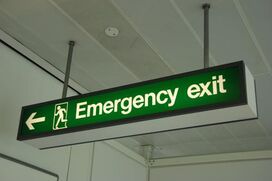
Emergencies in the office: 6 preparation tips
While few of us enjoy thinking about it, an array of workplace emergencies could potentially occur, threatening the lives and safety of your staff. Whether it's a fire, medical emergency, workplace violence, inclement weather or even a natural disaster, it's important to have comprehensive plans in place, should the unthinkable occur.
If you're a human resources professional or business manager, be sure to review the list of quick preparation tips below and get to work on your own office's emergency plans.
1. Plan for every eventuality.
However uncomfortable, it's important to sit down with your management team and brainstorm every potential threat that your office faces, the Occupational Safety and Health Administration explained. There are a number of emergency situations that could occur in any office across the country, such as fire, or an active shooter or medical emergency, and as such, every workplace contingency plan should have a strategy for dealing with those events.
"I had never really thought about our office having any type of emergency response plan until something actually happened that required one," says Sarah Owen, Manager of Operational Accounting at Beacon Hill Staffing Group. "I am glad that when it did happen, our group jumped into action, contacting emergency response professionals. We've taken CPR Training courses and developed an appropriate plan, because you never what what could happen. It's better to be prepared and have a response plan, as a group, to all emergency situations."
"On the West Coast, earthquake preparation plans must be put in place."
Beyond emergencies that every office can experience there are also threats that are unique to certain parts of the nation. For example, in the Central Plains and South East, it's important to devise a strategy for shelter and/or evacuation should a tornado strike. Similarly, on the West Coast, earthquake preparation plans must be put in place.
2. Educate employees.
It's important that your staff are given detailed information about your workplace emergency plans. Make sure everyone knows exactly where all of your office's fire escapes are, and the quickest and most effective way to escape should a situation that warrants evacuation arise, Alarm.org advised. It's also important to hold routine drills, to ensure that everyone is on the same page and understands the correct protocol.
For example, have a tornado drill, where everyone heads to the closest shelter, or a lockdown drill, wherein everyone finds somewhere safe to hide. Bedford and Edenvale News advised holding a drill at least once a year and train all new staff members on emergency policies during the on-boarding process. Although they may seem silly and superfluous at the time, drills could ending up saving lives one day.
3. Remove any hazards.
There are steps that you can take on a daily basis to ensure that the office environment is as safe as it possibly can be. Remove any hazards that pose a threat to health and safety, such as faulty wiring or large objects that could trip someone over. Ensure that all walkways are clear, especially fire exits and fire escapes. All fire exits should also be clearly marked, as mandated by law.

4. Consider a risk assessment.
Alongside your own emergency contingency plans, it may be a wise idea to enlist the services of a professional to conduct a thorough risk assessment of your property, OSHA explained. They will be able to point out any potential threats that you may not have anticipated, such as structural insecurity or, depending on your industry, chemical hazards.
5. Hold First Aid training.
Investing in First Aid training for at least some of your staff is an effective strategy and could help to save lives in the event of a medical emergency, OSHA explained. The source noted that organizations such as the fire department or American Red Cross can offer First Aid training. If your staff are not trained in first-aid, don't allow them to intervene. Instead ensure that 911 is dialed immediately.
6. Have a designated meeting point.
Set aside a meeting point outside of the building that everyone recognizes to meet after an emergency occurs. That way it's easier for managers to take roll call and ascertain if anyone is missing, OSHA detailed.
 Back to Top
Back to Top

